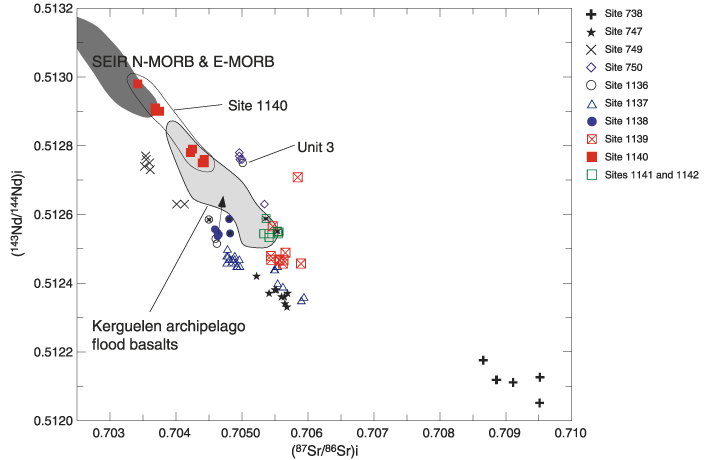
Figure F8. 143Nd/144Nd vs. 87Sr/86Sr for mafic rocks, dominantly tholeiitic basalt, except for alkalic basalt from Sites 1139, 1141, and 1142, recovered by drilling the igneous basement of the Kerguelen Plateau and Broken Ridge. All data are corrected to the time of eruption using measured parent/daughter abundances and ages from Duncan (2002) and Nicolaysen et al. (2000). Data sources are Site 738 (Mahoney et al., 1995), Sites 747, 749, and 750 (Frey et al., 2002b), Sites 1136, 1138, 1141, and 1142 (Neal et al., 2002), Site 1137 (Weis et al., 2001; Ingle et al.; 2002b), Site 1139 (Kieffer et al., 2002, only data for mafic lavas are plotted), and Site 1140 (Weis and Frey, 2002). The five data points with a black "x" within the symbol indicate unpublished data of D. Weis for geochemical reference samples selected to assess interlaboratory differences (one from Site 1136, two from Site 1138, and two from Sites 1141/1142). The results demonstrate the agreement of isotopic ratios for acid-leached samples obtained in the laboratories of D. Weis (Université Libre de Bruxelles) and J. Mahoney (University of Hawaii). The distinctive Unit 3 basalt at Site 1136 is labeled. Shown for comparison are fields for recent Southeast Indian Ridge (SEIR) mid-ocean-ridge basalt (MORB) (Mahoney et al., 2002) and the Cenozoic (24-30 Ma) flood basalt forming the Kerguelen archipelago (data sources are Yang et al., 1998; Doucet et al., 2002; Frey et al., 2000b, 2002a; D. Weis, unpubl. data). N-MORB and E-MORB = normal and enriched MORB, respectively. Important features are (a) lavas from most of the basement sites in the LIP define distinct fields with inverse correlation between 143Nd/144Nd and 87Sr/86Sr; the greatest scatter from an inverse trend is for the highly altered mafic lavas from Site 1139. (b) A large proportion of the data for LIP samples either overlap with the field for the Kerguelen archipelago or are offset to lower 143Nd/144Nd and 87Sr/86Sr. The offset of data for Sites 749, 1136, 1138, 1137, and 747 to lower ratios may reflect the eruption age differences (i.e., radiogenic ingrowth in the source from ~120 to 100 Ma for the plateau to ~25 to 30 Ma for the archipelago). For example, the arrow emanating from a Site 1138 data point shows the increase in 143Nd/144Nd and 87Sr/86Sr arising from 80 m.y. of ingrowth of a source with 147Sm/144Nd = 0.20 and 87Rb/86Sr = 0.06. These parent/daughter ratios are constrained by requiring that (Sm/Nd)source > (Sm/Nd)basalt and (Rb/Sr)source < (Rb/Sr)basalt. (c) Samples from Site 1140 are consistent with mixing between components related to SEIR MORB and the Kerguelen plume (e.g., Weis and Frey, 2002). (d) The extreme values for Site 738 have been interpreted as reflecting a component derived from continental lithosphere, probably crust (Mahoney et al., 1995). (e) Although not as obvious, the trends to relatively high 87Sr/86Sr at relatively low 143Nd/144Nd defined by basalt from Sites 1137 and 747 have also been attributed to a component derived from continental crust (Weis et al., 2001; Frey et al., 2002b; Ingle et al., 2002b).



![]()